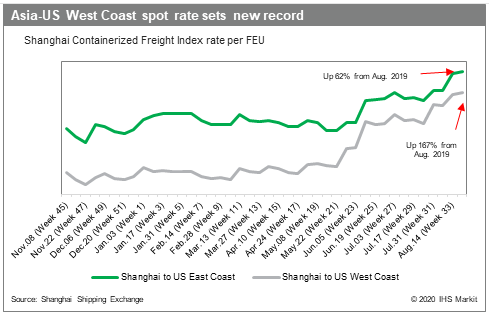Covid-19, Limited Capacity, and More Factors Have Driven Freight Rates to Set New Records
Although back-to-school season and holiday preparations consistently make August a peak season for ocean freight, this year is seeing a uniquely high increase – in both rates and capacity. The blanking of sailings earlier in the summer in response to the Covid-19 pandemic, combined with concerns over tariffs as the first trade agreement with China nears expiration, has generated a boom in demand that outpaces capacity. As a result, Asia-US West Coast spot rates have set new records, with Shanghai to US West Coast routes seeing a 167 percent increase from 2019.
Further, analysts are predicting another General Rate Increase (GRI) for trans-Pacific ocean cargo routes this month, marking the fifth since June 1. While earlier in the summer, increased rates were driven by significant numbers of blank sailings (a response to reduced exports from Asia due to Covid-19), these new GRIs are built on a surge of demand as inbound volume sees a year-over-year increase. We explored the factors at play in this increase, as well as potential future events that may impact rates further.

Capacity Versus Demand
Since the start of the year, capacity and demand have been drastically fluctuating. The onset of Covid-19 meant a sudden halt of economies, starting in China and Asia. With fewer imports – and lower consumer demand – carriers cut capacity radically, with 19 percent of total sailings blanked in May and 15 percent in June.
This summer, economies began to move again and US imports from Asia rose by more than 20 percent between June and July. In particular, a significant consumer demand for items like fitness equipment, at-home activities, and furniture, as well as the consistent demand for PPE, drove retailers to increase their imports to satisfy demand. Now, with only 3 West Coast sailings blanked for August and September, capacity is nearly back to normal – yet need for space is outpacing it. To combat this, carriers have added additional sailings from Asia, or “extra-loaders,” with 10 scheduled for August and an extra 5 for September; however, these additional sailings haven’t been enough to eliminate the capacity crunch, maintaining increased spot rates.
External Factors at Play
Beyond Covid-19, additional factors are also at play. Uncertainty surrounding the US-China trade deal has driven importers to bring their goods over from China earlier than normal, hoping to avoid the potential of a large tariff increase. Likewise, as the American election looms, importers and carriers alike are doing their best to anticipate potential shifts in the market.
Seasonal trends have also shifted – consumers are prioritizing furnishings and other goods for at-home use outside of their typical peak seasons and forgoing traditional purchases for this time of year like back-to-school gear or Halloween items.
We understand that tracking rates can be difficult. With years of experience in freight forwarding, we build our software SiShips. With this program, you can ensure your business is always receiving the best rate available – and get access to seamless cargo tracking, instant quotes, and more.
Contact us today to learn more about how SiShips can help streamline your import and export experience.

